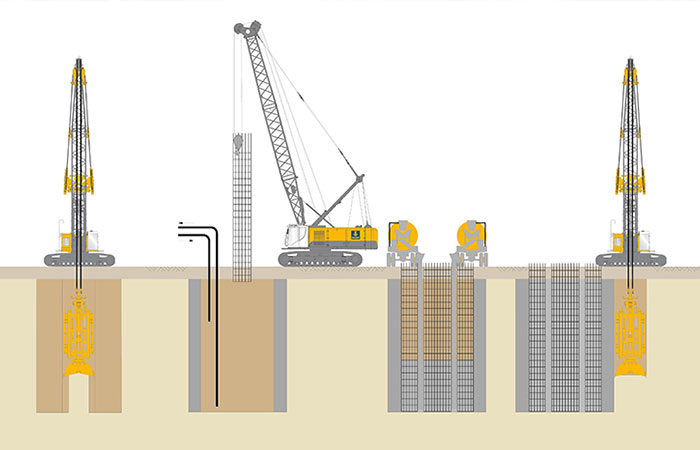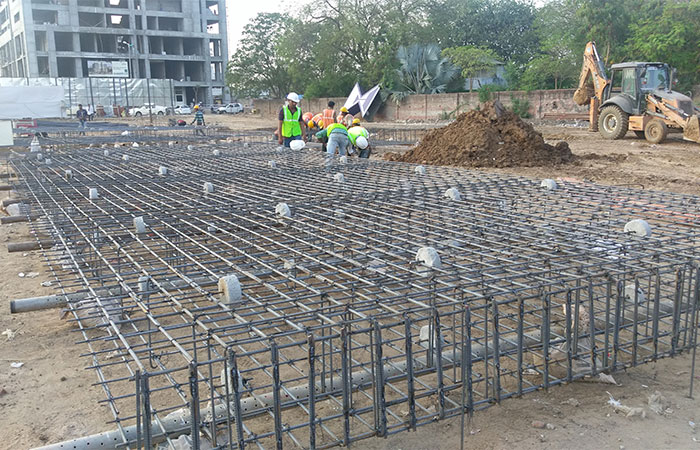Diaphragm Walls
Welcome to Mehul Geoprojects LLP: Your Premier Partner in Diaphragm Wall Construction!
At Mehul Geoprojects LLP, we take immense pride in being at the forefront of the construction industry, specializing in the intricate art of diaphragm wall construction. With a remarkable track record of successfully completing over 300 diaphragm wall projects, we have established ourselves as a trusted and reliable name in the realm of construction.
Our journey has been paved with innovation, precision, and a commitment to excellence. Diaphragm walls, often considered the backbone of modern urban construction, require both technical prowess and a deep understanding of engineering intricacies. With years of experience under our belt, we have not only honed these skills but have elevated them to an art form.
At Mehul Geoprojects, we don't just build walls; we erect foundations of trust, collaboration, and quality. Our team of highly skilled professionals, backed by cutting-edge technology, ensures that each project is not merely a construction endeavor but an expression of our dedication to crafting lasting structures. We approach every project with a unique perspective, tailoring our solutions to suit the specific needs and challenges posed by each site.
As you navigate through our website, you'll discover a portfolio that narrates the story of our expertise: a journey marked by successfully executed diaphragm wall projects across diverse terrains and industries. From urban landscapes to industrial complexes, our walls stand tall, symbolizing the strong pillars of our commitment, integrity, and unwavering dedication.
Join us in exploring the world of diaphragm walls, where engineering meets artistry and construction transforms into creation. Discover how Mehul Geoprojects LLP continues to shape skylines, strengthen foundations, and build a future that's as solid as the walls we construct.

Diaphragm Wall: A Modern Foundation Technique
An extremely meticulous process goes into erecting a structure. Project to project variations in specifications and permissions don't affect how things are done. Making wise choices is essential in this process because constructions take a long time. In order to access and complete due diligence, enough time should be set out.
What is a diaphragm wall?
A diaphragm wall (D-wall) is a solid concrete building structure that is panel by panel framed. Diaphragm walls are typically employed in full sites close to an existing structure when the earth and depth would make stacked walls difficult. For permanent retaining walls and shafts with fewer construction joints, D-walls offer an economical alternative. In addition, these walls provide support for important structures like dams, tunnels, and basements. These assist in laying the deep-dig foundation. Particularly well-liked by the walls are reclaimed regions. Diaphragm wall thickness can vary from 600 mm to 1800 mm and can be deep as much as 50 meters depending on the type of its application.
How Can Help You
Features of a diaphragm wall
Large depth
The d-wall may be built with ease due to the depth of the shaft wall that can be reached.
Small Ground Surface Settlement
A diaphragm wall can be used to manage the ground surface area, which is crucial in downtown regions.
Strong Adaptability
D-walls are highly adaptable and can be used for foundations, retaining walls, pile foundations, and other structures in a variety of plane shapes.
Convenient top-down construction
To manage the deformation of ground buildings and underground structures, top-down construction techniques can be combined with D-walls.
Construction procedure of a diaphragm wall
-
The process for building a diaphragm wall typically goes as follows:
-
Constructing a Guide Wall:
These walls serve as a model for the layout of a wall evacuation and help to keep the top trench stable. The d-walls' horizontal arrangement and connectivity are supported by the structure of these walls. A guide wall additionally holds the steel cages, marks the panel's location, and prevents soil collapse.
-
Evacuation to form a diaphragm wall trench:
-
This necessitates soil removal and stabilization. Panel excavation is done with a rectangular tool. The vertical panels are excavated using specialized clamshells like grabs and buckets. Cable or hydraulic power may be used to operate the digging machine.
-
Supporting trench cutting via a slurry:
The sides are strengthened using bentonite slurry. The pressure produced by this slurry is enough to keep the healthy soil in place.
-
Inert reinforcement and placement to form a wall panel:
Concrete is added to the panel that has been dug. A support cage is placed inside; depending on the depth, up to two cages can be added. Concrete is then put into the trench using tremie pipes after the cage has been added. The bentonite slurry is eliminated by the additional concrete. This slurry may be used once more.

Diaphragm wall connections
There are two main ways to make connections between diaphragm walls:
-
Stop End Pipes:
Two steel pipes are fastened to the channel before pouring the concrete. After concreting, this enables the use of a semi-circular section panel.
-
Disposable Pipes:
The second method involves attaching two PVC pipes to the split ends of steel panels used to construct fortification cages. On the main panel split behind the slurry, concrete is applied. The indentation between the other panel and the main panel is filled in while the other panel is being converted.
Working Process
Construction of Cast In-Situ Diaphragm Walls

-
Guide Walls
cast in-situ walls construction begins with
guide walls, which are parallel temporary walls. -
Excavation
Next step is execution of the excavation.
-
Reinforcement
When the excavation is completed
stop-end elements are placed inside. -
Concreting
Concrete is piped by one or more pipes,
depending on the largeness of the project -
Joints
D-walls technology is based on alternative panels,
which are connectedby the joints.
Purpose and advantages of diaphragm walls
For retaining excavations intended to support heavy structural loads, diaphragm walls are useful. Additionally, these D-walls aid in preserving watertightness. D-wall construction takes much less time and costs less money. Furthermore, this construction is accessible everywhere. These additional benefits of D-walls are as follows:
-
Diaphragm walls can also be used as a permanent wall structure.
-
The walls can be installed at greater depths.
-
Vibration and noise with the installation of a D-wall are less.
-
A rigid structure, so that ground movement from the excavation is less.
Application of diaphragm walls
Diaphragm walls work well for the following situations:
-
In areas of dense infrastructure
-
In areas where a very rigid retention system is required
-
In areas where vibration and noise are to be minimal
-
In areas where dewatering is not possible
-
In areas where the geology restricts a conventional retention system.
The most common applications are areas such as tunnels, deep basements,underpasses, underground car parks, and railway stations
Conclusion
While many building projects are rather simple, some call for more specialized methods that can take greater pressure while still being safe. For instance, diaphragm walls are used when a structure needs deep foundations. D-walls construct a sturdy subsurface structural element capable of withstanding a great deal of weight and strain. D-walls are essential to lots of commercial projects since they provide a very dependable way to build. One would not be able to see skyscrapers, protracted tunnels, or subterranean constructions without d-walls.
